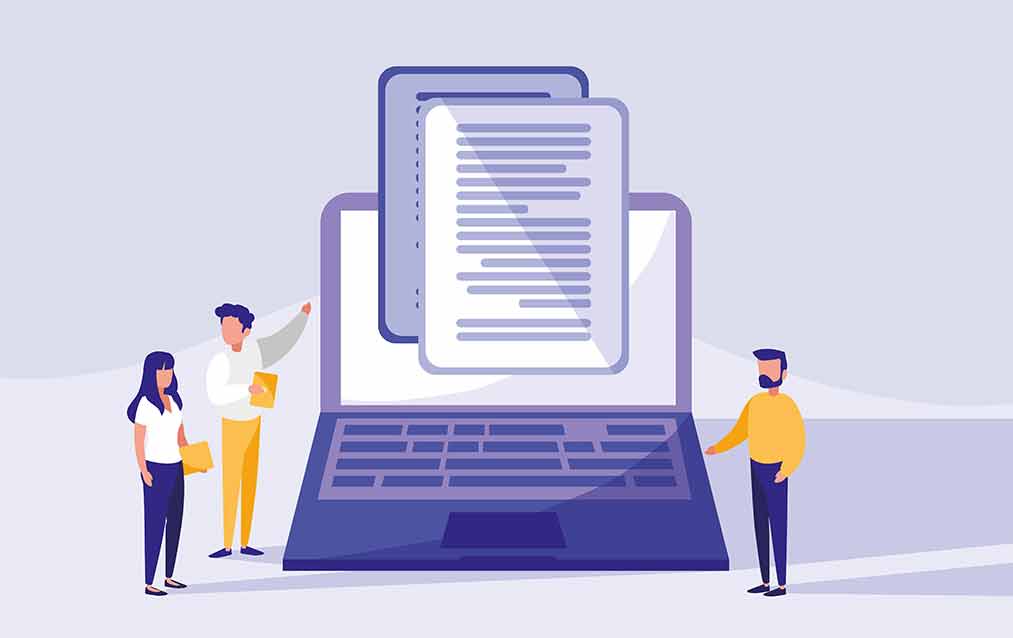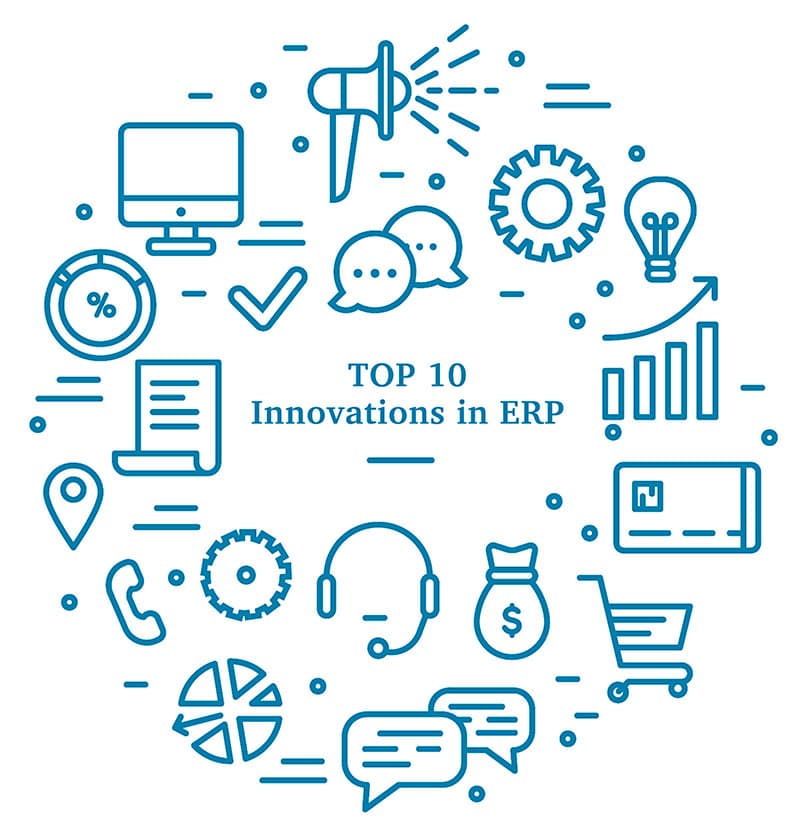Make Your Life Easier with SapphireOne’s Integrated Document Management
May 26, 2020 8:32 am | by John Adams

Some more so than others, but nearly all types of transactions involve paperwork needing to manually be sorted through and filed appropriately. This process is time-consuming and quite frankly, not very exciting for any accounting team member. However, SapphireOne has developed a solution readily available to your company as it offers an ERP software application with an integrated document management.
An ERP framework is a versatile accounting tool that supports the incorporation of different segments of any day-to-day business, ranging from processing of orders to managing inventories and shipments etc. Metaphorically speaking, an ERP software is the ‘Swiss army knife’ of data management. If it is coupled with an integrated document management system, the process of filing any paperwork stemming from various business activities becomes a walk in the park, as the two components work hand in hand to facilitate efficient and effective document management for any organisation or company.
The Benefits of Integrated Document Management
There are five distinct advantages for you and your company related to adopting SapphireOne’s ERP solution in respect of document management tasks such as sorting, searching and filing:
1. Time- and Labour-Efficient
An ERP system with the capacity for integrated document management allows you to conveniently sort and file large amounts of paperwork created by various transactions electronically with ease. The process also becomes much less labour-intensive, meaning your accounting team can shift their focus on more productive tasks.
2. Fluidity and Departmental Integration
The ERP solution offers the possibility of making your company function like one single beehive, interconnecting it on all fundamental levels and consequently, enabling instantaneous sharing of information between all departments, which leads to a high degree of fluidity that is desirable for any type of business. For instance, the customer service team will not need to contact the accounts department anymore in order to retrieve details on inventory, locations, taxes, customers or any other relevant information. Instead, any department can access all data directly via an ERP dashboard.
3. Privacy and Security
Any integrated management of documents via an ERP software application enables the implementation of a risk-stratified security protocol for accessing sensitive information contained within them. As a result, you can effectively specify and monitor who is able to, as well as who actually accesses, any protected data.
4. Lower Management Expenses
Unlike manual processes of organising, filing, sorting and searching paperwork, electronically managing documents incurs no additional expenditures for printing and storage of such. Further, it also reduces the need of allocating valuable human resources to tasks such as searching and filing of documents, as these can be attended to electronically i.e. in a more efficient manner. A reduction of paper consumption also has the positive outcome of improving the eco-friendliness of your company.
5. Improve Decision-making Process
An ERP compatible with integrated document management enhances your as well as your employees’ decision-making skills. By easing the access to all relevant data and information pertaining to branches such as sales, expenses and general transactions, all possible options and outcomes can be weighed up. Resultingly, the decision-maker can rest assured that the ultimate outcome is based on a foundation of thorough research. It is essentially the accumulation of such critical decisions that determine the fate of a company.
The integrated document management system offered by SapphireOne excels with its capacity of attaching documents to transactions and all major tables. If you would like for your business to be able to take advantage of all the aforementioned benefits, it is as easy as implementing SapphireOne’s world-class ERP, CRM & Business Accounting Software. Please contact us to request a live demo and/or read the testimonials from our long-standing clients.
Lodge your Tax Return effortlessly and spend time on your big idea
July 13, 2018 10:38 am | by John Adams

At the end of financial year whether you are in Australia, New Zealand or anywhere in the world, all companies have tax obligations. The requirement to produce your Profit & Loss and Balance Sheet at the end of the financial year is mandatory for all businesses and organisations.
A financial year (or fiscal year, or sometimes budget year) is the period used by governments and their tax agencies for accounting and budget purposes, which vary between countries. It is also used for financial reporting by business and other organizations. Laws in many tax jurisdictions/countries require company financial reports to be prepared and published on an annual basis, but generally do not require the reporting period to align with the calendar year. The End of Financial Year (EOFY) is the date that marks the end of the financial year.
The calendar year is used as the financial year by about two thirds of publicly traded companies in the United States and for a majority of large corporations in the UK and elsewhere, with notable exceptions being in Australia, New Zealand and Japan. In Australia the End of Financial year generally falls on June 30th, New Zealand ends their financial year on March 31st. Some organisations and companies follow the USA end their financial year which is often on the same day of the week each year, for example, the Friday closest to 31 December. Under such a system, some fiscal years will have 52 weeks and others 53 weeks.
Taxation laws generally require accounting records to be maintained and taxes calculated annually, which usually corresponds to the financial year used by the government. The calculation of tax on an annual basis is especially relevant for direct taxation, such as company income tax. Many annual government fees and levies—such as Council rates, licence fees, etc. are also calculated on a financial year basis, while others are charged on an anniversary basis.
Many educational institutions have a financial year which ends during the summer to align with the academic year (and, in some cases involving public universities, with the state government’s financial year), and because the university is normally less busy during the summer months. In the northern hemisphere this is July to the next June. In the southern hemisphere this is calendar year, January to December. Some media/communication-based organisations use a broadcast calendar as the basis for their fiscal year.
Whatever the size of your business and tax obligations, you must report and pay any amount due to the ATO, this includes Superannuation and GST, VAT or Sales Tax reporting. It is essential to lodge tax return accurately in order to achieve the maximum business offset and possibly even receive a tax refund.
By managing everything from Financial Reporting, Inventory Control, Assets, Job Projects, Payroll/HR to Bank Reconciliations, SapphireOne ERP CRM DMS can give you more time to do the things that matter, such as developing new strategies and thinking in your business or organisation.
SapphireOne helps you to prepare and lodge tax return
SapphireOne helps you calculate GST and seamlessly lodge your Business Activity Statement (BAS) Standard Business Reporting (SBR2), pay employees and track your PAYG and Superannuation.
SapphireOne ERP CRM DMS can generate comprehensive reports to help you prepare and lodge tax return. Effortless reporting of SapphireOne can help you to get the right data at the right time including Year to Date (YTD) financial reports, PAYG payment summaries, Profit & Loss and Balance Sheet reports.
For a sneak peek at the full capabilities ERP, CRM, Accounting Software, Human Resources, Payroll, Assets and Document Management, check out SapphireOne and request a live demo, it is everything you’ll ever need to make your company management a success. Know more about us.
Simplifying the concept of end of financial year
July 11, 2018 10:34 am | by John Adams

The Australian financial year typically starts from 1st July and ends on 30th June. The 30th June is also known as end of financial year when businesses start preparing their financial reports in order to submit their financial position to the Australian government. In New Zealand the end of financial year is on 31st March, in the United States of America the financial is typically the last Friday of December.
Documents needed for end of financial year
A range of documents are needed to assess the tax obligations of your business such as Income Statement, (also known as the Profit and Loss P&L) and Balance sheet.
The objective of financial statements is to provide information about the financial position, performance and changes in financial position of an enterprise that is useful to a wide range of users in making economic decisions. Financial statements should be understandable, relevant, reliable and comparable. Reported assets, liabilities, equity, income and expenses are directly related to an organization’s financial position.
Countries over time have developed their own accounting methods and principles, making international comparisons of companies difficult. To ensure comparability and uniformity between financial statements prepared by different companies, a set of guidelines and rules are used. Commonly referred to as Generally Accepted Accounting Principles (GAAP), these set of guidelines provide the basis in the preparation of financial statements.
SapphireOne ERP CRM DMS can support unlimited number of companies in unlimited tax jurisdictions in one data file. SapphireOne also support multiple foreign currencies and unlimited number of foreign bank accounts, supporting all your foreign exchange (FX) requirements.
Income statement / Profit and Loss (P & L)
The Income Statement or Profit and Loss (P & L) measures a company’s income and expenses during a specified period of time. A profit and loss statement provides information on the operation of the enterprise. These include sales and the various expenses incurred during the stated period.
The Income Statement is one of the most important financial statements a business or organisation issues annually, along with the balance sheet and the cash-flow statement.
SapphireOne ERP CRM DMS has the ability to run the current year versus last year reports, or if required up to ten years historical data on the one report.
SapphireOne also has the ability to copy last year’s actual general ledger balances into the current year’s budget.
Balance sheet
The company Balance Sheet represents company’s financial position, which is important at the end of financial year. The Balance Sheet outlines the total assets, liabilities and owner’s or stockholders’ equity at a specified point in time. Assets the business owns, such as vehicles, plant and equipment, property, intellectual property and cash in the bank are included on the Balance Sheet, depreciation of these assets is included on the Income Statement (P&L). Liabilities include your creditors, payroll obligations such as employee’s annual, carer and long-service accrued leave.
SapphireOne ERP CRM DMS financial reporting has the ability to export data to spreadsheet and also import data to the general ledger budget via the Sapphire API gateway.
For a sneak peek at the full capabilities ERP, CRM, Accounting Software, Human Resources, Payroll, Assets and Document Management, check out SapphireOne and request a live demo, it is everything you’ll ever need to make your company management a success. Know more about us.
Take your Business Enterprise to the next level with World Class Accounting ERP Application Innovation
June 12, 2018 10:22 am | by John Adams
Innovation in the Enterprise Resource Planning – ERP Application world is a very mature marketplace.
Some of the ERP vendors have been developing their applications for close to forty years, so true world class ground-breaking innovation development in these mature markets are rare and seldom. SapphireOne ERP Accounting provides Top 10 innovations in ERP.
Top 10 Innovations in ERP Application market :-
- Document Management system (DMS)
- HTML Web Server in a Client/Server application
- Softphone Integration CRM
- EDI/API Integration
- Barcode Scanning
- Material Resource Planning MRP
- ERP application Dashboard
- Single Touch Payroll (STP) & Standard Business Reporting (SBR2)
- PDF capture
- Material Safety Data Sheets
Document Management System (DMS)
An ERP application with document managing capabilities grants you the ability to conveniently sort and manage vast caches of transaction documents with ease in the shortest time possible. No longer will time be spent on unproductive activities like document filing and searching, the document management system will do all these in real-time.
Not only do you reduce running costs through decreased expenditure on paper and other stationery, your employees can focus on other more productive tasks. By reducing your paper consumption you’re also making your business eco-friendly.
A document management system allows you to implement a stratified documents and sensitive information access protocol. With this framework in place, you can effectively specify and monitor who has access to the documents.
HTML Web Server in A Client/Server application
SapphireOne provides a Web Pack solution with Top 10 innovations in ERP. This is a HTML webserver in-built into SapphireOne server which allows the ability to do data entry, client lookup, vendor look up and other functions from any device that supports a browser such as iPads, iPhones etc. SapphireOne Web Pack also provides the ability to set up and run unlimited Point of Sale (POS) web based stores.
Softphone Integration CRM
A Softphone is a software phone that enable users to call any telephone number without a physical telephone. The Softphone works in many ways such as Computer to Computer or phone to phone where VoIP telephone & adapter is required. Softphone is the bridge between VoIP network and telephone line or mobile network. It enables users to make a call between computer to a phone network and phone network to computer, when you have a dedicated number to receiver call.
The biggest benefit of having a Softphone is you can call any employee, client or supplier without having to worry about software matchup or whether or not they are online. It is a perfect solution for remote employees. A significant part of SapphireOne’s functionality is Customer Relationship Management (CRM). Inside SapphireOne CRM package, Softphone has been fully integrated into all aspects of the SapphireOne application. Whether you are calling clients, vendors, employees, or other contacts, all this can be driven from a single click on the softphone icon. This instantly keeps a date & time stamp with the ability to record the call. This built-in functionality can bring immense advantages in managing relationship with vendors, clients and employees.
EDI/API Integration
To manage orders and pay vendors on time, large organisations use electronic data interchange (EDI). EDI decreases the order-to-cash cycle time, i.e. suppliers to retailers get paid faster. This helps to maximise efficiency and minimise errors. EDI improves speed, accuracy, security and trade communication. More than just a data format, EDI is a system or method for exchanging business documents with external entities and integrating the data from those documents into your internal systems. Without EDI capabilities, a business has a greater risk of revenue loss from chargeback penalties, loss of opportunity to the processing delay, loss of reputation and credit with customers.
SPS Commerce’s fulfilment EDI has hundreds of document types covering most transaction types that are commonly used among vendors and suppliers. With a singular focus on the retail marketplace, SPS commerce has revolutionised traditional EDI systems, by developing a model that is the most cost-effective and reliable in the industry.
Barcode Scanning
Data synchronisation in the core ERP application is the biggest concern in Warehouse management or Inventory Management business. Barcode scanners automate the process of inventory management and stock control process. This eliminates the need for manual data entry and checklist evaluation process.
Barcode scanners are usually used to sell the product or to make inventory of the selected product. Scanner will help you to record all the information about the product and thus, streamlines the inventory management process. With Sapphire WebPack Solution all inventory management processes will be available out of the box, and there is no need to separately integrate ERP and barcode scanners.
Material Resource Planning MRP
Material Resource Planning (MRP) is a computer based inventory management system. MRP generates time-based manufacturing and purchasing plans for optimal inventory availability which is tied to historical data of customer demands. MRP is a subset of ERP for managing manufacturing requirements using integrated production planning and inventory controls. The main theme of MRP software is to “get the materials to the right place at the right time”. In any inventory management, regardless of the level of sophisticated technology used, the Saw Tooth pattern is followed. In this pattern there is a certain amount of inventory that you start with, then you consume it, stock levels drop, you reorder the stock, you receive this stock and the process continues.
SapphireOne ERP Application Dashboard
The ERP application Dashboard goes by many names. You most likely would have heard them being called Business Intelligences (BI) or Performance Indicator Dashboards. Regardless of the name, these features do one thing – present business statistics and performance indicators in a visually attractive and graphically intuitive interface. The SapphireOne ERP dashboard utilises graphs, bar charts and other visually engaging design elements that provide a succinct overview of a business’s financial standings.
Single Touch Payroll (STP) & Standard Business Reporting (SBR2)
From 1 July 2018, it is compulsory for all businesses with over 20 employees to report to the ATO after each pay event.
Single Touch Payroll (STP) aligns your reporting obligations of your payroll processes. The information you send the Australian Taxation Office (ATO) will include your employees’ salaries and wages, allowances, deductions (for example, workplace giving) and other payments, pay as you go (PAYG) withholding and superannuation information. SapphireOne is fully integrated with STP.
Standard Business reporting (SBR2) allows you to access and download your Business Activity Statement (BAS) directly from the ATO. This function can prefill the form with your BAS document number and other relevant fields.
PDF capture
The task of processing supplier invoices includes sorting documents, manual data entry and archiving the paperwork, this can be time consuming and inefficient. With SapphireOne PDF capture these negative effects can be easily avoided. SapphireOne uses the Optical Character Recognition (OCR) technology in PDF capture function that takes a paper document, usually an invoice, scans and “reads” it and turns it into metadata that can be used to populate fields in a database.
SapphireOne’s PDF capture function can help you streamline daily accounting tasks. Currently, few vendor invoices are processed through Electronic Data Interchange (EDI) which means that majority of vendor invoices are still received as PDF documents or paper. This makes the processing of capturing the data from a vendor invoice slow and inefficient. Mistakes in classification and data entry lead to late payments, missed discounts, deteriorating relationships with suppliers and cost overrides.
Material Safety Data Sheets
Any organisation or enterprise that is storing products as simple as food, motor vehicle fuel, and farm fertiliser, to dangerous products such as chemicals, pharmaceuticals, radioactive or explosive materials require Material Safety Data Sheets (MSDS).
SapphireOne inventory has integrated MSDS into the Inventory module which offers 30 unique alphanumeric fields, 10 unique numeric fields and 10 unique date fields which are fully customisable.


